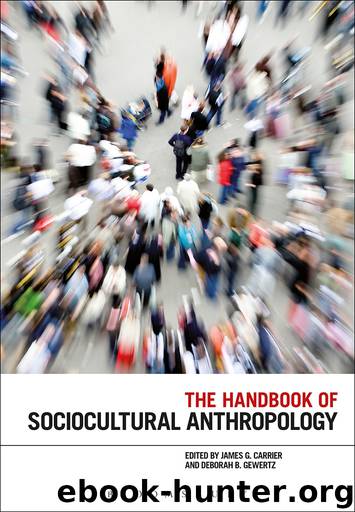The Handbook of Sociocultural Anthropology by James G. Carrier Deborah B. Gewertz & Deborah B. Gewertz

Author:James G. Carrier,Deborah B. Gewertz & Deborah B. Gewertz
Language: eng
Format: epub
Publisher: Bloomsbury UK
Published: 2013-03-13T16:00:00+00:00
HERE AND THERE: ETHNIC MINORITIES AND THE TROUBLE WITH CULTURE
While some anthropologists of migration in the 1970s and early in the 1980s were preoccupied with global connection and inequality, many more were engaged in the more conventional ethnographic work of studying migrants in situ. A small number focused on “sending” communities, providing detailed ethnographies of the historical preconditions and effects of migration (e.g., Kessinger 1974; Brandes 1975; Ballard 1983; Gardner 1995). Many more, however, looked at the newly formed communities of immigrants in the North.
Setting out to investigate questions of adaptation, assimilation, and cultural change, the task of anthropologists studying “settler” migrant communities seemed at first to be relatively straightforward (see Ballard 1994). Providing ethnographic descriptions of social networks, cultural customs and beliefs, and the social institutions of the homelands, most work aimed to provide knowledge of and insight into groups that seemed very separate from mainstream society and were still far from providing their own forms of representation (e.g., Dahya 1974; Jeffery 1976; see also Werbner 1990). The approach is perhaps summed up by James Watson’s (1979) edited collection, Between Two Cultures. In this volume, essays describe a variety of ethnic groups (Greek Cypriots, Pakistanis, Jamaicans, and so on), detailing the background to their migration to and settlement in Britain and outlining salient features of social organization. These studies reveal some important underlying assumptions: migrant groups partook in two distinct cultures, British and their country of origin; culture and place of origin were synonymous; migrants could be meaningfully studied and understood as separate and bounded groups.
By the 1990s, however, this approach was seen as essentializing. Increasingly, the perspective of cultural theorists such as Paul Gilroy, Stuart Hall, and Homi Bhabha dominated work on ethnicity and identity and culture, which had come to be seen as inherently unbounded and fluid (see Eriksen, Chap. 13; Friedman, Chap. 17). For example, Gilroy (1993: 15) argued that Britain’s black settler communities forged what he termed a “compound culture” from disparate sources. In his metaphor of the “Black Atlantic,” Gilroy (1993: 4) drew attention to the role of history and geography in the formation of this culture, using the image of slave ships crossing the seas of Africa and the Atlantic as living, microcultural, micropolitical systems in which ideas, activists, and cultural and political artifacts continually circulate. Here, the stress was context and history. Identity was not seen as fixed or dependent upon a given culture, but the outcome of shifting positions. While “diaspora culture” may produce ethnic absolutisms as part of its political project, these were seen as constructed, part of the cultural and political transfers between Africa and the North (Gilroy 1993: 199).
Gerd Baumann’s work in Southall is an excellent example of these new approaches. In Contesting Cultures, he (1996) describes how people from a variety of ethnic backgrounds or “communities” in Southall subscribe to both the “dominant discourse” (which associates particular ethnic groups with particular cultures) and the “demotic discourse” (in which the congruence between community and culture is denied). As
Download
This site does not store any files on its server. We only index and link to content provided by other sites. Please contact the content providers to delete copyright contents if any and email us, we'll remove relevant links or contents immediately.
| Anthropology | Archaeology |
| Philosophy | Politics & Government |
| Social Sciences | Sociology |
| Women's Studies |
Nudge - Improving Decisions about Health, Wealth, and Happiness by Thaler Sunstein(7615)
iGen by Jean M. Twenge(5366)
The Fire Next Time by James Baldwin(5249)
Adulting by Kelly Williams Brown(4487)
The Hacking of the American Mind by Robert H. Lustig(4318)
The Sports Rules Book by Human Kinetics(4294)
The Ethical Slut by Janet W. Hardy(4174)
Captivate by Vanessa Van Edwards(3796)
Mummy Knew by Lisa James(3634)
In a Sunburned Country by Bill Bryson(3485)
The Worm at the Core by Sheldon Solomon(3435)
Ants Among Elephants by Sujatha Gidla(3417)
The 48 laws of power by Robert Greene & Joost Elffers(3025)
Suicide: A Study in Sociology by Emile Durkheim(2973)
The Slow Fix: Solve Problems, Work Smarter, and Live Better In a World Addicted to Speed by Carl Honore(2947)
Humans of New York by Brandon Stanton(2835)
The Tipping Point by Malcolm Gladwell(2827)
Handbook of Forensic Sociology and Psychology by Stephen J. Morewitz & Mark L. Goldstein(2660)
The Happy Hooker by Xaviera Hollander(2655)
